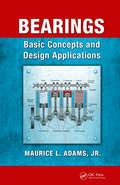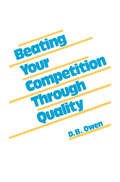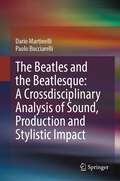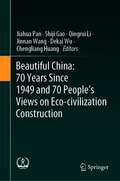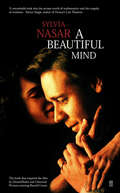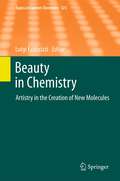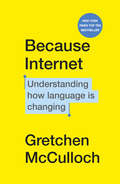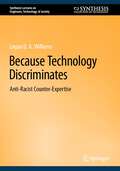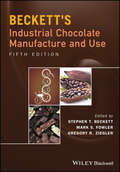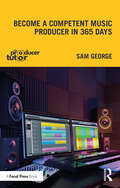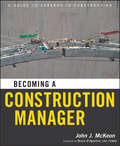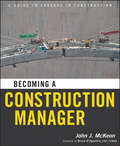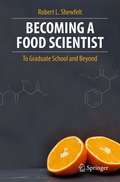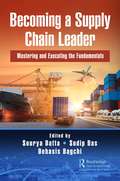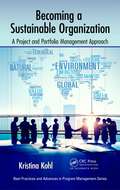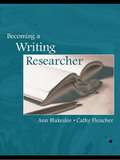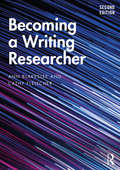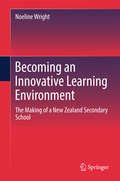- Table View
- List View
Bearings: Basic Concepts and Design Applications
by Maurice L. AdamsBearings: from Technoloogical Foundations to Practical Design Applications provides a modern study of bearing types, design factors, and industrial examples. The major classes of bearings are described, and design concepts are covered for rolling elements, surfaces, pivots, flexures, and compliance surfaces. Fluid film lubrication is presented, and the basics of tribology for bearings is explained. The book also looks at specific applications of bearing technology, including bearings in vehicles, rotating machinery, machine tools, and home appliances. Case studies are also included.
Bearings: Basic Concepts and Design Applications
by Maurice L. AdamsBearings: from Technoloogical Foundations to Practical Design Applications provides a modern study of bearing types, design factors, and industrial examples. The major classes of bearings are described, and design concepts are covered for rolling elements, surfaces, pivots, flexures, and compliance surfaces. Fluid film lubrication is presented, and the basics of tribology for bearings is explained. The book also looks at specific applications of bearing technology, including bearings in vehicles, rotating machinery, machine tools, and home appliances. Case studies are also included.
Beating Your Competition Through Quality
by D. B. OwenThis book describes how superior quality is attained and gives some of the basic techniques involved. It gives clear insight into the impact of variation on the future of the World and addresses the statistical problems.
Beating Your Competition Through Quality
by D. B. OwenThis book describes how superior quality is attained and gives some of the basic techniques involved. It gives clear insight into the impact of variation on the future of the World and addresses the statistical problems.
The Beatles and the Beatlesque: A Crossdisciplinary Analysis of Sound Production and Stylistic Impact
by Dario Martinelli Paolo BucciarelliThe Beatles and the Beatlesque address a paradox emanating from The Beatles’ music through a cross-disciplinary hybrid of reflections, drawing from both, musical practice itself and academic research. Indeed, despite their extreme stylistic variety, The Beatles’ songs seem to always bear a distinctive identity that emerges even more in similar works by other artists, whether they are merely inspired, derivative or explicitly paying homage. The authors, a musicologist and music producer, emphasize the importance of record production in The Beatles' music in a way that does justice not only to the final artifacts (the released songs) but also to the creative process itself (i.e., the songs "in the making").Through an investigation into the work of George Martin and his team, as well as The Beatles themselves, this text sheds light on the role of the studio in shaping the group's eclectic but unique sound. The chapters address what makes a song “Beatlesque”, to what extent production choices are responsible for developing a style, production being understood not as a mere set of technicalities, but also in a more conceptual way, as well as the aesthetics, semiotics and philosophy that animated studio activity. The outcome is a book that will appeal to both students and researchers, as well as, of course, musicophiles of all kinds.
Beautiful China: 70 Years Since 1949 and 70 People’s Views on Eco-civilization Construction
by Jiahua Pan Shiji Gao Qingrui Li Jinnan Wang Dekai Wu Chengliang HuangThis book discusses and studies the basic course of ecological civilization construction in the 70 years since the founding of the People’s Republic of China and summarizes the experience and lessons. It contains 75 articles from 75 top experts and government officials in the field of ecological civilization policy-making and basic theory research in China, including Xi Jinping Thought on Ecological Civilization, ecological culture, green industry economy, environmental quality, legal system, ecological security and so on, so as to provide reference for understanding and studying the progress of ecological environment protection since the founding of China.
A Beautiful Mind (Shooting Script Ser.)
by Sylvia NasarA Beautiful Mind is Sylvia Nasar's award-winning biography about the mystery of the human mind, the triumph over incredible adversity, and the healing power of love.At the age of thirty-one, John Nash, mathematical genius, suffered a devastating breakdown and was diagnosed with schizophrenia. Yet after decades of leading a ghost-like existence, he was to re-emerge to win a Nobel Prize and world acclaim. A Beautiful Mind has inspired the Oscar-winning film directed by Ron Howard and featuring Russell Crowe in the lead role of John Nash.
Beauty in Chemistry: Artistry in the Creation of New Molecules (Topics in Current Chemistry #323)
by Luigi FabbrizziThe Beauty of Chemistry in the Words of Writers and in the Hands of Scientists, by Margherita Venturi, Enrico Marchi und Vincenzo Balzani Living in a Cage Is a Restricted Privilege, by Luigi Fabbrizzi Inner and Outer Beauty, by Kenneth N. Raymond und Casey J. Brown The Mechanical Bond: A Work of Art, by Carson J. Bruns und J. Fraser Stoddart The Beauty of Knots at the Molecular Level, by Jean-Pierre Sauvage und David B. Amabilino
Because Internet: Understanding how language is changing
by Gretchen McCullochTHE ACCLAIMED NEW YORK TIMES BESTSELLER. Because Internet is for anyone who's ever puzzled over how to punctuate a text message or wondered where memes come from. It's the perfect book for understanding how the internet is changing the English language, why that's a good thing, and what our online interactions reveal about who we are. Language is humanity's most spectacular open-source project, and the internet is making our language change faster and in more interesting ways than ever before. Internet conversations are structured by the shape of our apps and platforms, from the grammar of status updates to the protocols of comments and @replies. Linguistically inventive online communities spread new slang and jargon with dizzying speed. What's more, social media is a vast laboratory of unedited, unfiltered words where we can watch language evolve in real time. Even the most absurd-looking slang has genuine patterns behind it. Internet linguist Gretchen McCulloch explores the deep forces that shape human language and influence the way we communicate with one another. She explains how your first social internet experience influences whether you prefer 'LOL' or 'lol', why ~sparkly tildes~ succeeded where centuries of proposals for irony punctuation had failed, what emoji have in common with physical gestures, and how the artfully disarrayed language of animal memes like lolcats and doggo made them more likely to spread.'McCulloch is such a disarming writer - lucid, friendly, unequivocally excited about her subject - that I began to marvel at the flexibility of the online language she describes, with its numerous shades of subtlety.' New York Times
Because Technology Discriminates: Anti-Racist Counter-Expertise (Synthesis Lectures on Engineers, Technology, & Society #27)
by Logan D. WilliamsEngineers designing technologies and systems produce problems when they do not account for existing biases in society. Designers have a mandate to make technologies efficiently, economically, and ethically. This textbook is written for both students and practicing designers, engineers, researchers, or artists who want to create more ethical designs; it aims to help readers understand how race is implicated in technology design. Learning from historical and contemporary case studies of engineering and architecture projects will help readers see clearly the power of design decisions to either perpetuate or contest racism. Chapter exercises will change engineers’ mental models to see the bias inherent to existing technological design. By incorporating the knowledge and insights of community-based experts into design projects, readers will begin to practice anti-racist leadership and counter-expertise.
Beckett's Industrial Chocolate Manufacture and Use
by Stephen T. Beckett Mark S. Fowler Gregory R. ZieglerSince the publication of the first edition of Industrial Chocolate Manufacture and Use in 1988, it has become the leading technical book for the industry. From the beginning it was recognised that the complexity of the chocolate industry means that no single person can be an expert in every aspect of it. For example, the academic view of a process such as crystallisation can be very different from that of a tempering machine operator, so some topics have more than one chapter to take this into account. It is also known that the biggest selling chocolate, in say the USA, tastes very different from that in the UK, so the authors in the book were chosen from a wide variety of countries making the book truly international. Each new edition is a mixture of updates, rewrites and new topics. In this book the new subjects include artisan or craft scale production, compound chocolates and sensory.This book is an essential purchase for all those involved in the manufacture, use and sale of chocolate containing products, especially for confectionery and chocolate scientists, engineers and technologists working both in industry and academia.The new edition also boasts two new co-editors, Mark Fowler and Greg Ziegler, both of whom have contributed chapters to previous editions of the book. Mark Fowler has had a long career at Nestle UK, working in Cocoa and Chocolate research and development – he is retiring in 2013. Greg Ziegler is a professor in the food science department at Penn State University in the USA.
Beckett's Industrial Chocolate Manufacture and Use
by Steve T. BeckettSince the publication of the first edition of Industrial Chocolate Manufacture and Use in 1988, it has become the leading technical book for the industry. From the beginning it was recognised that the complexity of the chocolate industry means that no single person can be an expert in every aspect of it. For example, the academic view of a process such as crystallisation can be very different from that of a tempering machine operator, so some topics have more than one chapter to take this into account. It is also known that the biggest selling chocolate, in say the USA, tastes very different from that in the UK, so the authors in the book were chosen from a wide variety of countries making the book truly international. Each new edition is a mixture of updates, rewrites and new topics. In this book the new subjects include artisan or craft scale production, compound chocolates and sensory.This book is an essential purchase for all those involved in the manufacture, use and sale of chocolate containing products, especially for confectionery and chocolate scientists, engineers and technologists working both in industry and academia.The new edition also boasts two new co-editors, Mark Fowler and Greg Ziegler, both of whom have contributed chapters to previous editions of the book. Mark Fowler has had a long career at Nestle UK, working in Cocoa and Chocolate research and development – he is retiring in 2013. Greg Ziegler is a professor in the food science department at Penn State University in the USA.
Become a Competent Music Producer in 365 Days
by Sam GeorgeBecome a Competent Music Producer in 365 Days is a comprehensive, step-by-step guide to the fundamentals of music-production. Over the course of a year, this book takes the reader through ten chapters covering mixing, equalization, compression, reverb, delay and modulation, automation, vocals, synthesis, and mastering. To combat the patchy nature of ‘fast’ online content, this book provides an accessible and easily digestible course. Each chapter is broken down into daily readings and tasks, so that each topic can be fully explored, understood, and implemented before moving onto the next, with a range of online video tutorials that offer useful companion material to the book. Become a Competent Music Producer in 365 Days is an ideal introduction for beginners of all backgrounds, and students in further and higher education music-production classes, as well as aspiring professionals, hobbyists, and self-taught producers, who wish to have a thorough grasp on all the fundamental topics that any experienced music producer should know.
Become a Competent Music Producer in 365 Days
by Sam GeorgeBecome a Competent Music Producer in 365 Days is a comprehensive, step-by-step guide to the fundamentals of music-production. Over the course of a year, this book takes the reader through ten chapters covering mixing, equalization, compression, reverb, delay and modulation, automation, vocals, synthesis, and mastering. To combat the patchy nature of ‘fast’ online content, this book provides an accessible and easily digestible course. Each chapter is broken down into daily readings and tasks, so that each topic can be fully explored, understood, and implemented before moving onto the next, with a range of online video tutorials that offer useful companion material to the book. Become a Competent Music Producer in 365 Days is an ideal introduction for beginners of all backgrounds, and students in further and higher education music-production classes, as well as aspiring professionals, hobbyists, and self-taught producers, who wish to have a thorough grasp on all the fundamental topics that any experienced music producer should know.
Becoming a Construction Manager (Wiley Desktop Editions Ser.)
by John J. McKeonThe must-have guide for anyone considering a career in construction management Becoming a Construction Manager explains everything a person needs to know to become a Construction Manager—from formal education to getting their first job. This practical guide is packed with useful information for anyone considering or beginning a career in construction management, as well as professional construction managers seeking to work in a specific area. From schedule and cost management to sustainability and technology implementation, all of the important career choices are explained by successful construction managers at top international firms. The only guide available on careers in this fast-growing field Offers practical guidance in a concise, easy-to-use format, illustrated throughout In-depth profiles with construction managers of varying specialties give students and new architects an inside view of the real-world, day-to-day experiences of a working builder Includes interviewing tips and up to date information on where the jobs are in the field, along with an extensive resource section on professional organizations and educational opportunities Introduction by Bruce D'Agostino, President and CEO of the Construction Management Association of America Providing an overview of the profession, educational requirements, specialties, and the job search, this is a one-stop resource that supplies the inside track on this rapidly growing profession.
Becoming a Construction Manager
by John J. McKeonThe must-have guide for anyone considering a career in construction management Becoming a Construction Manager explains everything a person needs to know to become a Construction Manager—from formal education to getting their first job. This practical guide is packed with useful information for anyone considering or beginning a career in construction management, as well as professional construction managers seeking to work in a specific area. From schedule and cost management to sustainability and technology implementation, all of the important career choices are explained by successful construction managers at top international firms. The only guide available on careers in this fast-growing field Offers practical guidance in a concise, easy-to-use format, illustrated throughout In-depth profiles with construction managers of varying specialties give students and new architects an inside view of the real-world, day-to-day experiences of a working builder Includes interviewing tips and up to date information on where the jobs are in the field, along with an extensive resource section on professional organizations and educational opportunities Introduction by Bruce D'Agostino, President and CEO of the Construction Management Association of America Providing an overview of the profession, educational requirements, specialties, and the job search, this is a one-stop resource that supplies the inside track on this rapidly growing profession.
Becoming a Food Scientist: To Graduate School and Beyond
by Robert L. ShewfeltBecoming a Food Scientist is designed as a reservoir of ideas for those beginning a graduate education in food science or beginning a professional career in the field. Although at times it may read as a how-to manual for success in graduate school, it is meant to encourage each reader to study the research process, to challenge conventional wisdom, and to develop a career path that maximizes the probability of success both in school and beyond. The author has viewed food science graduate programs through the lenses of programs at four universities and service in numerous activities with the Institute of Food Technologists. This book is thus focused on the field of food science, but it may have relevance to other scientific disciplines. The book introduces the concept of research as process in the first chapter. Subsequent chapters focus on individual unit operations of research: idea generation, problem definition, critical evaluation of the literature, method selection, experimental design, data collection, processing and analysis, and knowledge dissemination. Successful graduate students in food science must master each of these operations. The final section of the book pushes the reader beyond graduate school into its practice in the real world. Topics covered in the maturation of a food scientist include the scientific meeting, critical thinking, science and philosophy, ethics, finding and managing the literature, planning, grantsmanship, laboratory setup and management, and career development. This book should be a meaningful companion for any graduate student in the field and those transitioning from graduate school to the food science profession.
Becoming a Supply Chain Leader: Mastering and Executing the Fundamentals
by Sourya DattaThe book explains how to emerge and grow as a supply chain leader and details supply chain and procurement processes and operational activities in real-work scenarios across multiple supply chain verticals. The book defines what an entry-level supply chain professional must do to excel in various types of supply chain verticals such as IT, electronics manufacturing, pharmaceutical, retail, and consumer goods. Apart from helping professionals understand vertical specific nuances, this book helps them to set both short-term goals for annual performance review and longer-term career planning. In addition, for a mid- or senior-level supply chain professional, the book offers ideas on ways to launch initiatives and demonstrate leadership to foster career growth. It offers ideas about unlocking new values for the organization and creating a data-driven decision support platform to gain financial efficiency for better management of CapEx and OpEx spend, thus improving the bottom line. The book includes a tool kit which includes operational data models, financial models, and presentation templates for creating and socializing proposals intended for cross-functional teams and demonstrating supply chain leadership. The book is divided into four major parts. In Part I, the book starts with an overview of key concepts in a manufacturing supply chain and procurement organization. It describes current forms of modern global supply chain and corporate procurement organizations. The objective of Part II is to provide a framework for a self-directed supply chain manager to understand how a large organization evaluates the contribution of supply chain managers and where it expects them to create value. To foster career growth as a supply chain professional, the book identifies six key knowledge pillars for demonstrating supply chain mastery: Technical and market knowledge of the end product and its constituents. Knowledge of internal product development and sustaining processes and supporting consumption data. Health and market condition of the supplier. Ability to create value. Ability to build internal and external executive relationships with key influencers. Ability to obtain best cost without compromising on quality and lead time. Negotiating cost, sourcing material, and then the logistics of moving the raw material through multiple stages and finally finished materials across the globe are some of the key areas which need continuous improvement. As a sentinel of efficiency, removing any kind of wastage leads to immediate value creation and contributes to the margin by improving the bottom line. In Part III, the book reviews twelve such verticals namely printer, medical, IT, energy, automotive, cloud, dairy, data management, avionics, biotech, apparel and start up and the supply chain nuances through the lenses of the framework created in Part II. In Part IV, the book goes back to focus on the professional growth of an individual supply chain person in an industry agnostic way. It provides examples of financial and operational efficiencies that a supply chain professional can create.
Becoming a Supply Chain Leader: Mastering and Executing the Fundamentals
by Sourya Datta Sudip Das Debasis BagchiThe book explains how to emerge and grow as a supply chain leader and details supply chain and procurement processes and operational activities in real-work scenarios across multiple supply chain verticals. The book defines what an entry-level supply chain professional must do to excel in various types of supply chain verticals such as IT, electronics manufacturing, pharmaceutical, retail, and consumer goods. Apart from helping professionals understand vertical specific nuances, this book helps them to set both short-term goals for annual performance review and longer-term career planning. In addition, for a mid- or senior-level supply chain professional, the book offers ideas on ways to launch initiatives and demonstrate leadership to foster career growth. It offers ideas about unlocking new values for the organization and creating a data-driven decision support platform to gain financial efficiency for better management of CapEx and OpEx spend, thus improving the bottom line. The book includes a tool kit which includes operational data models, financial models, and presentation templates for creating and socializing proposals intended for cross-functional teams and demonstrating supply chain leadership. The book is divided into four major parts. In Part I, the book starts with an overview of key concepts in a manufacturing supply chain and procurement organization. It describes current forms of modern global supply chain and corporate procurement organizations. The objective of Part II is to provide a framework for a self-directed supply chain manager to understand how a large organization evaluates the contribution of supply chain managers and where it expects them to create value. To foster career growth as a supply chain professional, the book identifies six key knowledge pillars for demonstrating supply chain mastery: Technical and market knowledge of the end product and its constituents. Knowledge of internal product development and sustaining processes and supporting consumption data. Health and market condition of the supplier. Ability to create value. Ability to build internal and external executive relationships with key influencers. Ability to obtain best cost without compromising on quality and lead time. Negotiating cost, sourcing material, and then the logistics of moving the raw material through multiple stages and finally finished materials across the globe are some of the key areas which need continuous improvement. As a sentinel of efficiency, removing any kind of wastage leads to immediate value creation and contributes to the margin by improving the bottom line. In Part III, the book reviews twelve such verticals namely printer, medical, IT, energy, automotive, cloud, dairy, data management, avionics, biotech, apparel and start up and the supply chain nuances through the lenses of the framework created in Part II. In Part IV, the book goes back to focus on the professional growth of an individual supply chain person in an industry agnostic way. It provides examples of financial and operational efficiencies that a supply chain professional can create.
Becoming a Sustainable Organization: A Project and Portfolio Management Approach (Best Practices And Advances In Program Management Ser.)
by Kristina KohlOrganizations find that a performance gap exists between sustainability vision and benefits realization. Effecting transformational change requires incorporating sustainability into organization's culture including policies, processes, and people. Although they are often overlooked, project management professionals and HR professionals are valuable
Becoming a Writing Researcher
by Ann M. Blakeslee Cathy FleischerBecoming a Writing Researcher effectively guides students through the stages of conducting qualitative writing research, from the initial step of seeing themselves as researchers, to identifying research questions, selecting appropriate tools, conducting the research, and interpreting and reporting the findings. Authors Ann M. Blakeslee and Cathy Fleischer describe various qualitative methods and provide readers with examples of real-world applications. Exercises and activities, as well as anecdotes from both novice and seasoned researchers, serve to acquaint readers thoroughly with the practice of carrying out research for scholarly or professional purposes. The textbook introduces students to research methods in a gradual and contextualized manner. Each chapter opens with a discussion of general issues regarding a particular portion of the research process, followed by a consideration of the various physical, conceptual, and strategic tools that allow a beginning researcher to conduct that part of the process. Sections within each chapter also cover: personal and theoretical perspectives and biases that influence specific stages of the research process ethical issues associated with phases of the research process the identity, ethos, and experiences of the researcher. Becoming a Writing Researcher is an essential text for all novice researchers, and is well suited for use in graduate-level research methods courses in composition and technical communication. It is also ideal for use in other disciplines with strong qualitative methodology research programs, including education.
Becoming a Writing Researcher
by Ann M. Blakeslee Cathy FleischerBecoming a Writing Researcher effectively guides students through the stages of conducting qualitative writing research, from the initial step of seeing themselves as researchers, to identifying research questions, selecting appropriate tools, conducting the research, and interpreting and reporting the findings. Authors Ann M. Blakeslee and Cathy Fleischer describe various qualitative methods and provide readers with examples of real-world applications. Exercises and activities, as well as anecdotes from both novice and seasoned researchers, serve to acquaint readers thoroughly with the practice of carrying out research for scholarly or professional purposes. The textbook introduces students to research methods in a gradual and contextualized manner. Each chapter opens with a discussion of general issues regarding a particular portion of the research process, followed by a consideration of the various physical, conceptual, and strategic tools that allow a beginning researcher to conduct that part of the process. Sections within each chapter also cover: personal and theoretical perspectives and biases that influence specific stages of the research process ethical issues associated with phases of the research process the identity, ethos, and experiences of the researcher. Becoming a Writing Researcher is an essential text for all novice researchers, and is well suited for use in graduate-level research methods courses in composition and technical communication. It is also ideal for use in other disciplines with strong qualitative methodology research programs, including education.
Becoming a Writing Researcher
by Cathy Fleischer Ann BlakesleeBecoming a Writing Researcher effectively guides students through the stages of conducting qualitative writing research, from the initial step of seeing themselves as researchers, to identifying research questions, selecting appropriate methodological tools, conducting the research, and interpreting and reporting findings. Exercises and activities, as well as anecdotes and examples from both novice and seasoned researchers, serve to acquaint readers thoroughly with the practice of carrying out research for scholarly or professional purposes. This second edition introduces students to research methods in a gradual and contextualized manner. Each chapter offers a discussion of a particular portion of the research process, followed by consideration of physical, conceptual, and strategic tools that allow a master’s level researcher to conduct that part of the research. Sections within each chapter also cover issues of stance and positionality that impact the researcher and the resulting research. Becoming a Writing Researcher, second edition, is an essential text for all novice researchers and is particularly well suited for use in graduate-level research methods courses in writing studies and technical communications. It is also ideal for use in other disciplines with strong qualitative methodology research programs, including education.
Becoming a Writing Researcher
by Cathy Fleischer Ann BlakesleeBecoming a Writing Researcher effectively guides students through the stages of conducting qualitative writing research, from the initial step of seeing themselves as researchers, to identifying research questions, selecting appropriate methodological tools, conducting the research, and interpreting and reporting findings. Exercises and activities, as well as anecdotes and examples from both novice and seasoned researchers, serve to acquaint readers thoroughly with the practice of carrying out research for scholarly or professional purposes. This second edition introduces students to research methods in a gradual and contextualized manner. Each chapter offers a discussion of a particular portion of the research process, followed by consideration of physical, conceptual, and strategic tools that allow a master’s level researcher to conduct that part of the research. Sections within each chapter also cover issues of stance and positionality that impact the researcher and the resulting research. Becoming a Writing Researcher, second edition, is an essential text for all novice researchers and is particularly well suited for use in graduate-level research methods courses in writing studies and technical communications. It is also ideal for use in other disciplines with strong qualitative methodology research programs, including education.
Becoming an Innovative Learning Environment: The Making of a New Zealand Secondary School
by Noeline WrightThis book traces how a new school, physically designed as a modern learning environment, has come into being in New Zealand. A key feature is how it designs its curriculum for future citizens. The book explores how flexible curriculum and assessment options support the provision of a well-balanced, coherent and future-oriented learning programme. It also illustrates how the school is implementing its vision and copes with being different from other schools which understand and embody the New Zealand Curriculum as well as the NCEA qualifications system in more traditional terms. School leaders’, teachers’ and foundation students’ thinking and perspectives about what it’s like to become a new school are highlighted and shed light on what is possible within an evolving education system.
